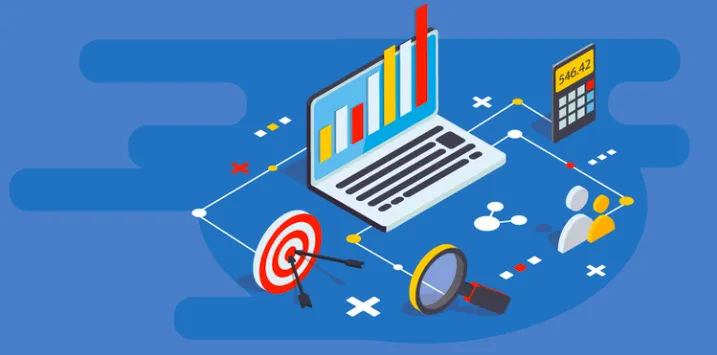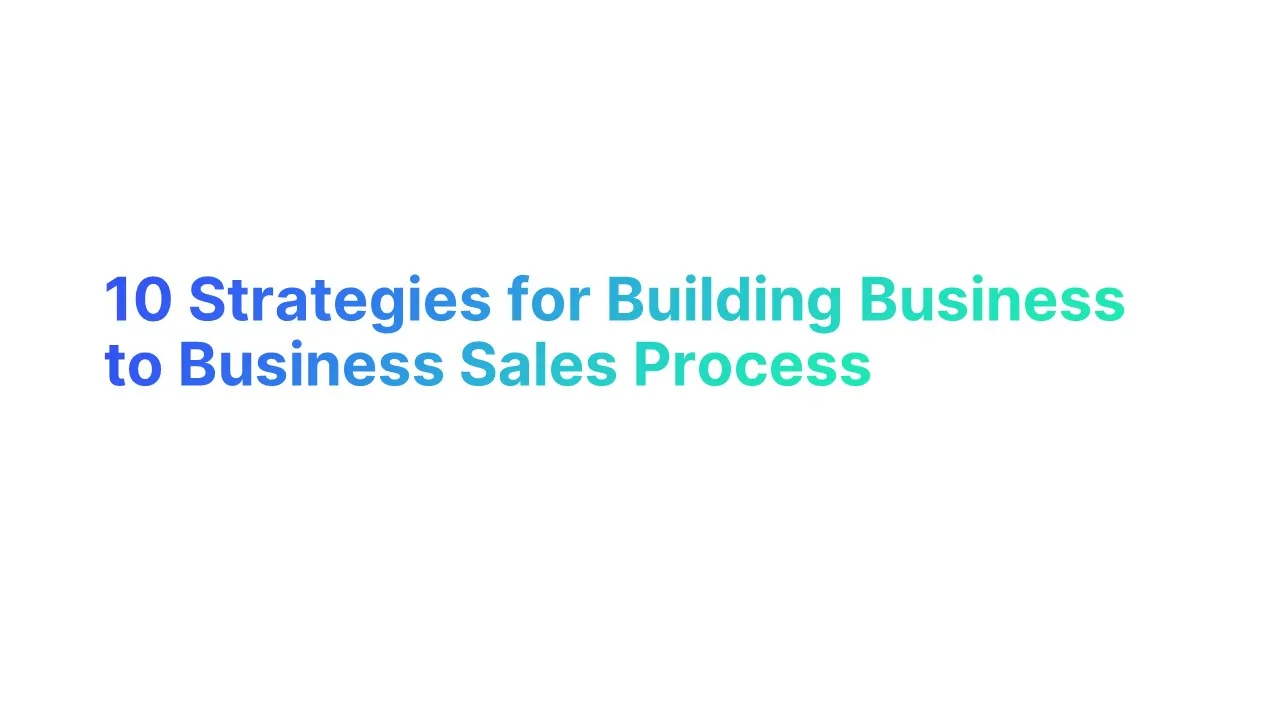Introduction to B2B Sales

B2B (business-to-business) sales refer to the process where one business makes a commercial transaction with another. This can include a variety of industries and is typically characterized by longer sales cycles and multiple decision-makers.
Here are a few points that highlight the significance of B2B sales:
- Market Size: B2B ecommerce transactions are expected to reach $1.8 trillion by 2023, accounting for 17% of all B2B sales in the U.S. alone.
- Higher Transaction Values: B2B transactions typically have a higher average transaction value compared to business-to-consumer (B2C) sales. This is because businesses purchase in larger quantities and often subscribe to services on an ongoing basis.
- Complex Decision-Making: B2B sales often involve multiple stakeholders, which can extend the sales cycle but also provide opportunities for deeper relationship building and larger contracts.
What is the Need for a B2B Sales Process
Implementing a structured B2B sales process is crucial for several reasons:
- Predictability: A clear sales process provides a roadmap for sales teams, enabling more predictable outcomes and systematic achievement of sales targets.
- Efficiency: It streamlines operations, reduces the sales cycle time, and minimizes resource wastage, allowing sales teams to focus on leads with the highest conversion potential.
- Scalability: A standardized sales process is easier to teach and replicate across new team members, facilitating business growth and scalability.
- Customer Relationship Management: Effective sales processes help in maintaining strong customer relationships, crucial for securing repeat business and referrals, which are often the lifeblood of B2B companies.
Stages of B2B Sales Cycle

The B2B sales cycle consists of several structured phases, each critical for advancing potential customers towards a purchase. Understanding these stages helps sales teams effectively nurture leads, optimizing both time and resources.
1. Lead Generation
This initial stage is all about identifying potential buyers (leads) who may have an interest in the products or services offered.
- Marketing Efforts: Utilizing content marketing, SEO, and social selling to attract prospects. Businesses leveraging advanced content strategies can generate over 67% more leads monthly compared to those without.
- Networking and Referrals: Participating in industry events and leveraging existing relationships can increase lead generation by up to 55%.
- Cold Calling and Emails: Despite being traditional, these methods still provide a significant return, with email marketing offering an ROI of $42 for every $1 spent.
2. Discovery
After generating leads, the next step is to learn more about them and their needs.
- Initial Contact: Sales reps engage with leads to gather more information and establish rapport.
- Assessment: This involves understanding the lead’s business, pain points, and requirements to tailor future communications effectively.
3. Qualification
Not all leads are suitable. This stage filters out the most promising ones based on their likelihood to buy.
- BANT Framework: Leads are evaluated based on Budget, Authority, Need, and Timing.
- Lead Scoring: Assigning values to leads based on interaction data helps prioritize those most likely to convert, boosting sales efficiency by up to 30%.
4. The Sales Pitch
The final persuasive communication designed to close the deal.
- Customized Presentations: Tailoring the pitch to address specific business needs and pain points can increase conversion rates by up to 70%.
- Solution Selling: Focusing on how the product/service solves specific problems rather than just selling features.
- Objection Handling: Preparing for potential objections and addressing them effectively during the pitch can improve success rates dramatically.
5. Question Handling
This stage involves addressing any queries or concerns potential buyers may have.
- Detailed Responses: Providing thorough and well-informed answers to questions about the product, sales process, or company. Effective question handling can increase customer satisfaction by 18%.
- FAQs and Resources: Sharing frequently asked questions (FAQs) and relevant resources can preemptively resolve common issues.
- Customer Testimonials: Using testimonials and case studies to reassure potential customers of the product’s effectiveness.
6. Closing the Deal
This crucial phase focuses on finalizing the sale and getting a commitment from the buyer.
- Negotiation: Engaging in discussions to finalize terms and conditions. Successful negotiation strategies can improve closing rates by 27%.
- Contracts and Agreements: Ensuring all legal and financial documents are clear and ready for signing.
- Final Proposal: Presenting a final proposal that outlines all agreed-upon terms, emphasizing the value and benefits to the potential buyer.
7. Following Up
Maintaining contact post-pitch is essential to nurture the relationship and address any lingering concerns.
- Regular Communication: Sending follow-up emails and making phone calls to keep the lead warm and answer any further questions.
- Providing Additional Information: Sharing more detailed insights or additional content related to the lead’s specific needs.
- Feedback Collection: Gathering feedback on the sales process to identify areas for improvement.
How to Build a B2B Sales Process

Building an effective B2B sales process is crucial for achieving consistent sales performance and driving business growth. A well-structured sales process helps sales teams stay organized, improves efficiency, and enhances the customer experience.
1. Define Your Sales Stages
A clear definition of each stage in your sales process is the foundation of an effective B2B sales strategy.
- Prospecting: Identify and reach out to potential customers. This stage is crucial as it sets the tone for future interactions. Effective prospecting can increase conversion rates by up to 300%.
- Lead Qualification: Evaluate leads to determine their potential value. Use criteria such as Budget, Authority, Need, and Timing (BANT) to assess each lead’s likelihood of becoming a customer.
- Needs Analysis: Understand the specific needs and pain points of your leads. This helps tailor your sales pitch and demonstrates your commitment to solving their problems.
- Proposal: Present a customized solution that addresses the lead’s needs. Ensure your proposal is clear, concise, and highlights the benefits of your solution.
- Negotiation and Closing: Engage in discussions to finalize the deal. Effective negotiation techniques can significantly impact the outcome of this stage.
- Post-Sale Follow-Up: Maintain contact with the customer to ensure satisfaction and encourage repeat business. This stage is critical for building long-term relationships.
2. Develop a Lead Scoring System
Implementing a lead scoring system helps prioritize leads based on their likelihood to convert, ensuring that sales teams focus their efforts on the most promising prospects.
- Criteria for Scoring: Use factors such as lead behavior, demographics, and engagement level. Leads engaging with high-value content, such as whitepapers or webinars, often have higher conversion potential.
- Automation Tools: Leverage CRM software to automate lead scoring. Tools like Salesforce or HubSpot can help manage and score leads efficiently, improving sales productivity by up to 29%.
- Regular Review: Continuously review and adjust the lead scoring criteria based on performance data to ensure it remains effective.
3. Create a Sales Playbook
A sales playbook provides a standardized approach for sales teams, ensuring consistency and efficiency throughout the sales process.
- Standardized Procedures: Document best practices, scripts, and responses to common objections. This ensures all team members follow the same high standards.
- Training and Onboarding: Use the playbook to train new sales reps. Well-trained reps can reach full productivity 50% faster with a comprehensive playbook.
- Continuous Improvement: Regularly update the playbook based on feedback and new insights to keep it relevant and effective.
4. Implement Sales Enablement Tools
Sales enablement tools provide sales teams with the resources they need to engage effectively with leads and close deals.
- Content Management Systems: Use platforms like Seismic or Highspot to organize and distribute sales materials. Sales reps spend 30% less time searching for content when using such systems.
- CRM Software: Implement CRM software to manage customer interactions and data. This enhances customer relationship management and provides valuable insights into the sales process.
- Analytics and Reporting: Use analytics tools to track performance metrics. Regular reporting helps identify bottlenecks and areas for improvement, leading to a 15% increase in sales productivity.
5. Measure and Optimize
Regular measurement and optimization of the sales process are crucial for continuous improvement and long-term success.
- Key Performance Indicators (KPIs): Track KPIs such as conversion rates, sales cycle length, and customer acquisition cost. These metrics provide insights into the effectiveness of the sales process.
- Feedback Loops: Establish feedback loops with sales teams to gather insights and identify challenges. Regular feedback sessions can improve team performance by 20%.
- A/B Testing: Conduct A/B testing for different sales tactics and strategies. This helps identify the most effective approaches and refine the sales process accordingly.
10 Strategies for Building B2B Sales Process

Creating an effective B2B sales process involves more than just following traditional steps. It requires innovative strategies that address real-world challenges and leverage modern technologies to enhance efficiency and results. Here are 10 intelligent strategies to build a robust B2B sales process:
1. Implement Account-Based Marketing (ABM)
Account-Based Marketing (ABM) focuses on targeting specific high-value accounts with personalized marketing and sales efforts. Account based Sales aligns marketing and sales teams to deliver a cohesive and tailored approach to each target account.
Why ABM?
ABM ensures that your resources are concentrated on accounts with the highest potential return, increasing the efficiency of your sales process.
How to Implement:
- Identify Target Accounts: Use data analytics to identify high-value prospects. Focus on companies that align with your ideal customer profile.
- Personalize Outreach: Develop customized content and marketing campaigns tailored to each target account’s specific needs and pain points.
- Collaborate Across Teams: Ensure tight alignment between marketing and sales teams to provide a seamless experience for the target accounts.
2. Leverage AI and Machine Learning for Lead Scoring
Artificial Intelligence (AI) and Machine Learning (ML) can significantly enhance the lead scoring process by analyzing vast amounts of data to identify patterns and predict lead behavior more accurately.
Why AI and ML?
These technologies provide a more precise and dynamic lead scoring model, improving the quality of leads passed to the sales team.
How to Implement:
- Data Collection: Gather comprehensive data on lead interactions, demographics, and engagement history.
- Model Training: Use ML algorithms to analyze this data and create predictive models that score leads based on their likelihood to convert.
- Continuous Improvement: Regularly update the models with new data to refine the scoring accuracy.
3. Develop a Multi-Channel Engagement Strategy
A multi-channel engagement strategy ensures that your sales process reaches prospects through various touchpoints, increasing the chances of engagement and conversion.
Why Multi-Channel?
Engaging leads through multiple channels such as email, social media, phone calls, and events provides a comprehensive approach that meets prospects where they are.
How to Implement:
- Channel Selection: Identify the most effective channels for your target audience through market research and customer feedback.
- Integrated Campaigns: Create integrated marketing campaigns that deliver consistent messages across all channels.
- Analytics and Adjustment: Use analytics tools to track engagement across channels and adjust strategies based on performance data.
4. Utilize Sales Enablement Platforms
Sales enablement platforms provide sales teams with the tools, content, and information they need to engage effectively with prospects and close deals.
Why Sales Enablement?
These platforms streamline the sales process, improve collaboration, and ensure that sales reps have access to the most relevant and up-to-date information.
How to Implement:
- Platform Selection: Choose a sales enablement platform that integrates with your existing CRM and marketing tools.
- Content Management: Use the platform to organize and distribute sales content, such as case studies, whitepapers, and presentations.
- Training and Onboarding: Provide training for sales reps on how to use the platform effectively to maximize its benefits.
5. Establish a Feedback Loop for Continuous Improvement
A feedback loop ensures that your sales process is continuously refined based on real-time data and insights from the sales team.
Why Feedback Loop?
Regular feedback helps identify bottlenecks, areas for improvement, and successful tactics, leading to an ongoing optimization of the sales process.
How to Implement:
- Regular Check-Ins: Schedule regular meetings with sales teams to gather feedback on the sales process and identify challenges.
- Performance Metrics: Track key performance indicators (KPIs) such as conversion rates, sales cycle length, and customer satisfaction.
- Iterative Improvements: Use the feedback and performance data to make iterative improvements to the sales process.
6. Implementing Predictive Analytics in Your Sales Funnel
Predictive analytics uses historical data, statistical algorithms, and machine learning techniques to identify the likelihood of future outcomes.
This approach can significantly enhance your sales process by forecasting trends and customer behaviors, thereby improving your sales funnel efficiency.
Why Predictive Analytics?
Predictive analytics helps in identifying high-potential leads, optimizing resource allocation, and forecasting sales trends, leading to better decision-making. This tool empowers sales professionals and marketing teams to focus their efforts on the most promising opportunities.
How to Implement:
- Data Integration: Collect and integrate data from various sources, including CRM systems, social media, and transaction histories.
- Algorithm Development: Develop predictive models using historical data to forecast future sales opportunities and lead behaviors.
- Regular Updates: Continuously refine models with new data to improve accuracy and relevance.
7. Enhance Personalization with AI-Driven Insights
Personalization goes beyond using a prospect’s name in emails. Advanced AI-driven insights can tailor content and interactions based on a deep understanding of each lead’s behavior and preferences, crucial for both business-to-business (B2B) and business-to-consumer (B2C) sales.
Why Enhanced Personalization?
Personalized interactions build stronger relationships and increase the likelihood of conversion by making prospects feel understood and valued.
How to Implement:
- Behavioral Tracking: Use AI tools to monitor and analyze lead interactions across various channels.
- Content Personalization: Tailor content recommendations and communication based on individual lead profiles and behaviors.
- Dynamic Messaging: Implement dynamic messaging in emails and on your website that adapts to each lead’s preferences and past interactions.
8. Utilize Video Marketing
Video marketing is a powerful tool for engaging prospects, explaining complex products, and building trust in the B2B sales process, making it a vital strategy for sales rep.
Why Video Marketing?
Videos are highly engaging and can effectively communicate value propositions, demonstrate product features, and share customer testimonials.
How to Implement:
- Educational Videos: Create videos that educate prospects about your industry, solutions, and best practices.
- Product Demonstrations: Develop detailed product demo videos that showcase features and benefits.
- Customer Testimonials: Use video testimonials to provide social proof and build credibility.
9. Develop Interactive Content
Interactive content such as quizzes, assessments, and calculators can engage prospects more effectively by providing personalized insights and immediate value, enhancing the sales funnel for other businesses.
Why Interactive Content?
It actively involves prospects, making the experience more engaging and memorable, which can lead to higher conversion rates.
How to Implement:
- Quizzes and Assessments: Develop tools that help prospects assess their needs or challenges and see how your solution can help.
- ROI Calculators: Create calculators that show potential return on investment (ROI) from using your product or service.
- Interactive Case Studies: Use interactive elements in case studies to highlight key points and results dynamically.
10. Implement a Customer Success Program
A customer success program ensures ongoing support and value delivery to your clients, leading to higher retention rates and upsell opportunities, essential for both B2B and B2C sales.
Why Customer Success?
Proactive customer success initiatives help in building long-term relationships, reducing churn, and increasing customer lifetime value.
How to Implement:
- Onboarding Process: Develop a comprehensive onboarding process that helps new customers quickly realize the value of your product or service.
- Regular Check-Ins: Schedule regular check-ins to ensure customers are achieving their desired outcomes and address any issues.
- Upsell and Cross-Sell: Use customer success teams to identify opportunities for upselling and cross-selling based on customer usage and needs.
How to Build an Effective Sales Team

Building an effective sales team involves strategic planning, hiring, training, motivation, and management. Here’s a concise guide:
1. Define Your Sales Strategy
- Set Goals: Use SMART criteria.
- Identify Target Market: Understand your ideal customer profile.
- Sales Process: Outline the buyer's journey from lead generation to closing deals.
2. Hire the Right People
- Key Traits: Look for strong communication skills, resilience, and a results-driven mindset.
- Assessments: Use sales aptitude tests and personality assessments.
- Cultural Fit: Ensure candidates align with company values.
3. Provide Comprehensive Training
- Onboarding: Cover product knowledge, sales techniques, and policies.
- Ongoing Training: Regular sessions on industry trends and sales tools.
- Mentorship: Pair new hires with experienced mentors.
4. Equip with the Right Tools
- CRM Systems: Manage leads and track sales activities.
- Sales Tools: Use tools for prospecting, communication, and content management.
- Data Analytics: Gain insights into performance and improvement areas.
5. Motivate and Incentivize
- Compensation Plan: Competitive base salary, commission, and bonuses.
- Recognition: Awards, public recognition, and career advancement.
- Team Building: Positive culture through activities and feedback.
6. Monitor and Optimize Performance
- KPIs: Measure performance with key indicators.
- Reviews: Regular feedback and goal setting.
- Continuous Improvement: Analyze data and implement changes.
7. Foster Collaboration
- Cross-Departmental: Promote collaboration with marketing and customer service.
- Regular Meetings: Discuss progress and share best practices.
8. Lead by Example
- Strong Leadership: Be approachable and provide clear direction.
- Open Communication: Maintain open lines for concerns and updates.
Concluding Thoughts
Creating a robust B2B sales process involves strategic planning and execution to address complex decision-making and higher transaction values. Each step, from lead generation to closing the deal, requires careful attention and tailored approaches to meet the specific needs of business clients.
Sales reps must leverage advanced tools, continuous training, and effective collaboration across teams to ensure efficiency and scalability.
By implementing these strategies, businesses can streamline their sales processes, enhance customer relationships, and ultimately drive significant growth in their B2B sales efforts, distinguishing it from traditional business-to-consumer sales.









